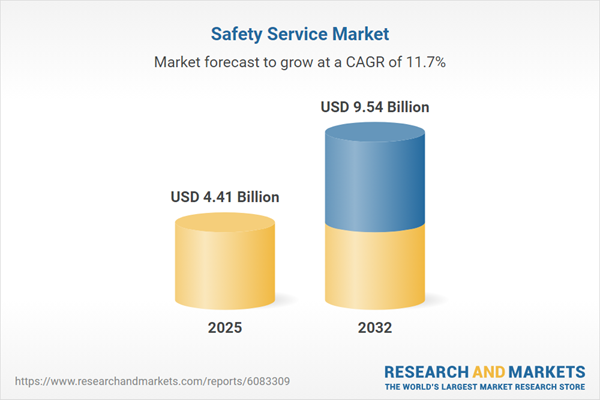Speak directly to the analyst to clarify any post sales queries you may have.
The Safety Service Market is undergoing significant transformation, driven by rapid digital integration, shifting regulatory frameworks, and the increasing demand for transparent, comprehensive safety compliance across sectors. Senior decision-makers are reassessing priorities as evolving challenges create new criteria for supplier selection and risk management.
Market Snapshot: Safety Service Market Size and Growth
The Safety Service Market grew from USD 3.94 billion in 2024 to USD 4.41 billion in 2025 and is expected to expand at a CAGR of 11.66%, reaching USD 9.54 billion by 2032. Rising regulatory scrutiny, increasing operational complexities, and technological innovation are prompting organizations to seek integrated safety and compliance platforms to manage risk and maintain operational continuity.
Scope & Segmentation
- Service Types: Certification & Compliance, Consulting & Advisory, Inspection Services, Testing Services, Training Services
- Delivery Modes: Offsite, Onsite
- Engagement Models: Project-Based, Retainer-Based
- Organization Sizes: Large Enterprises, Small and Medium Enterprises
- End Users: Chemicals & Petrochemicals, Construction & Infrastructure, Healthcare, Manufacturing, Mining & Metals, Oil & Gas, Transportation
- Regional Coverage: Americas, Europe Middle East & Africa, Asia-Pacific
- Key Technologies: IoT-enabled sensors, advanced analytics, augmented reality, cloud-based asset management, digital platforms
- Notable Companies: Allied Universal Security Services, Securitas AB, G4S plc, ADT Inc., GardaWorld Security Corporation, The Brink’s Company, Prosegur Compañía de Seguridad, ICTS International N.V.
Key Takeaways for Senior Stakeholders
- Integrated solutions blending digital monitoring with advisory services deliver streamlined compliance and operational resilience in complex environments.
- Increasing regulation is expanding the strategic focus from hazard mitigation to proactive risk management and corporate reputation safeguarding.
- Technological advancement enables predictive maintenance and remote inspections, optimizing safety outcomes and reducing disruptions.
- Strategic alliances across technology, consulting, and compliance fields accelerate service innovation and broaden addressable markets.
- Regional dynamics influence both demand profiles and the pace of digital adoption, requiring tailored approaches for each major market.
- Diversification of supplier networks and local partnerships reinforce adaptability against global economic headwinds.
Tariff Impact: Effects of 2025 U.S. Tariffs on the Safety Service Ecosystem
The 2025 United States tariffs have materially impacted cost structures, especially in inspection and specialized testing equipment procurement. Organizations are reshaping sourcing strategies, increasingly favoring local and nearshore suppliers to mitigate additional expenses and ensure supply chain resilience. Service providers are strengthening domestic capabilities with regional workshops and calibration centers, supporting continued compliance despite economic shifts.
Methodology & Data Sources
This Safety Service Market analysis synthesizes primary research—featuring interviews with executives, safety managers, and regulatory authorities—with secondary research across industry reports and technical journals. Data triangulation and statistical validation ensure the robustness and reliability of market findings.
Why This Report Matters
- Gain actionable intelligence on segmentation, regional opportunities, and the impact of evolving regulations to inform strategic direction.
- Leverage insight on technology adoption and operational transformation to enhance competitive positioning and client relationships.
- Use validated benchmarks and industry developments to guide investment, partnership, and compliance initiatives with confidence.
Conclusion
This comprehensive analysis equips leaders to proactively navigate regulatory change, integrate emerging technologies, and unlock new value streams. Align strategy to evolving market drivers and secure resilient growth in the future of safety services.
Table of Contents
3. Executive Summary
4. Market Overview
7. Cumulative Impact of Artificial Intelligence 2025
Companies Mentioned
The companies profiled in this Safety Service market report include:- Allied Universal Security Services, LLC
- Securitas AB
- G4S plc
- ADT Inc.
- GardaWorld Security Corporation
- The Brink's Company
- Prosegur Compañía de Seguridad, S.A.
- ICTS International N.V.
Table Information
| Report Attribute | Details |
|---|---|
| No. of Pages | 198 |
| Published | November 2025 |
| Forecast Period | 2025 - 2032 |
| Estimated Market Value ( USD | $ 4.41 Billion |
| Forecasted Market Value ( USD | $ 9.54 Billion |
| Compound Annual Growth Rate | 11.6% |
| Regions Covered | Global |
| No. of Companies Mentioned | 9 |









